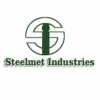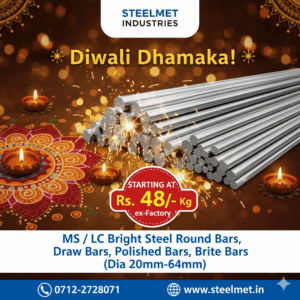🏭 Introduction:
When precision matters, tolerances make all the difference. In applications where bright bars are used — from gears to shafts, fasteners to hydraulic spindles — even a few microns of variation can affect performance, fitment, or cost.
This guide from Steelmet Industries helps you understand bright bar tolerances in leading international systems — ISO, IS, JIS, ANSI, and more — and how to select the right tolerance grade for your application.
📐 What is Bright Bar Tolerance?
Bright bar tolerance refers to the allowable dimensional deviation from the nominal (target) size of a bright bar. This deviation is tightly controlled based on the intended application and manufacturing standard. The tolerance band becomes critical in automated machining, fitting, and high-load assemblies.
📊 Tolerance Comparison Table
| Section Type | Size Range (mm) | Size Range (inches) | Standard | Grade / Notation | Tolerance Band (mm) | Total Variation | Notes |
|---|---|---|---|---|---|---|---|
| Rounds | 3 – 6 | 0.12 – 0.24″ | ISO 286-2 | h9 | -0.025 to -0.052 | 0.027 mm | Precision fit, high-speed machining |
| Rounds | 6 – 30 | 0.24 – 1.18″ | ISO 286-2 | h11 | -0.060 to -0.150 | 0.090 mm | General machining use |
| Squares | 10 – 40 | 0.39 – 1.57″ | IS 9550 | h11 | ~ -0.08 to -0.18 | 0.10 – 0.20 mm | Used in frames, bushes, couplings |
| Hexagons | 5 – 50 | 0.20 – 2.00″ | IS 9550 | h11 | ~ -0.07 to -0.18 | ~0.10 mm | Common in fastener industry |
| Flats | 10×3 – 100×20 | – | ISO / IS | h11 (width), K13 (thickness) | -0.20 to -0.80 | Varies by dimension | Different tolerances on width vs thickness |
| Custom Bars | 5 – 100 | – | As agreed | Customer Spec | Project-specific | Custom tolerance | Round corners, tapered edges, D-shapes etc. |
Note: Inch conversions are approximate. Please verify before procurement.
📚 Mini Glossary: Tolerance Terms
| Term | Meaning |
|---|---|
| Tolerance Grade | Classification of how much deviation is allowed from nominal |
| h9 / h11 | ISO standard tolerance classes. h9 is tighter than h11 |
| Total Variation | The full range between maximum and minimum acceptable size |
| Cold Drawn | Bars drawn through dies to achieve accurate sizes |
| Peeled Bars | Bars peeled on machines for precise finish and tolerances |
❓ FAQ – Bright Bar Tolerances
Q1. What is the most common bright bar tolerance grade?
A: h11 is the most commonly used tolerance grade. It balances precision and cost-effectiveness.
Q2. Are tolerances uniform across shapes?
A: No. Tolerances vary between rounds, hex, squares, and flats. Flats typically have different tolerances on width and thickness.
Q3. Can Steelmet supply inch-tolerance bright bars?
A: Yes. Steelmet Industries manufactures bars per ANSI and ASME inch tolerances on demand.
Q4. Do tolerance bands increase with size?
A: Yes. Larger sections generally allow wider tolerance bands.
Q5. Can special profiles have specific tolerances?
A: Absolutely. Steelmet supplies custom bars with specified tolerances per drawing or client specification.
🧪 A Real-World Scenario:
One automotive component manufacturer faced excessive rejections during fitment due to inconsistent bar dimensions from local suppliers. Steelmet Industries replaced them with certified h9 and h11 bright bars, resulting in 98% reduction in rejections and improved CNC throughput. That’s the impact of the right tolerance.
🧰 Applications that Rely on Tight Tolerances
CNC Machined Shafts
Precision Fasteners
Hydraulic Spindles
Engine Valve Parts
Gear Shafts & Couplings
Agricultural Implement Joints
📢 Call-to-Action
Looking for bright bars with verified tolerances, mill test reports, and dimensional certification?
👉 Contact Steelmet Industries — where accuracy, consistency, and service are not just promises, but processes.
Visit us at 🌐 www.steelmet.in or get in touch for your specification.


